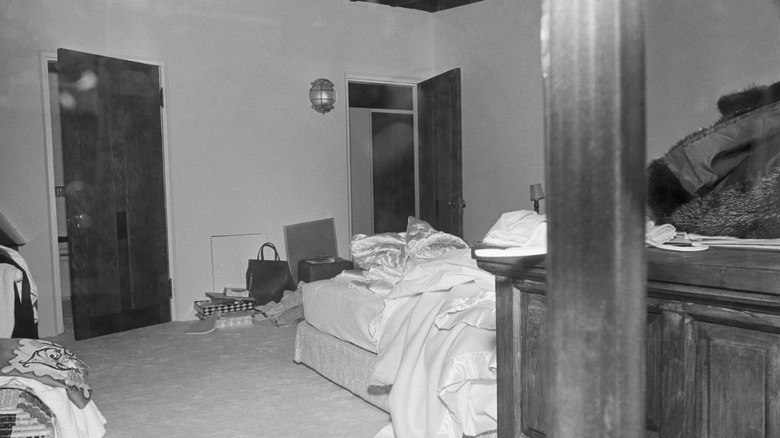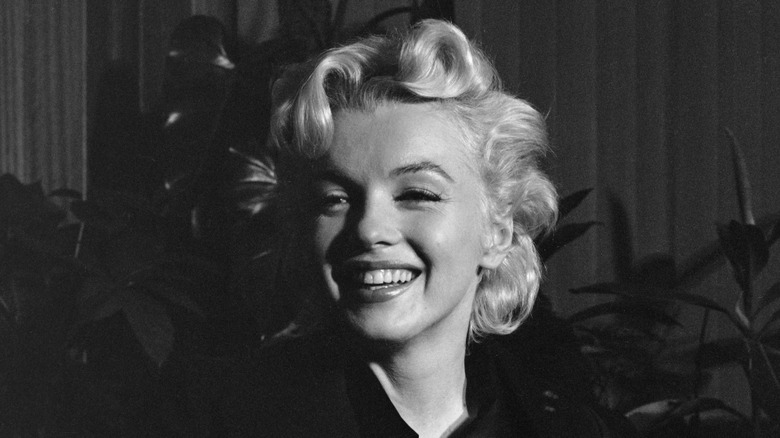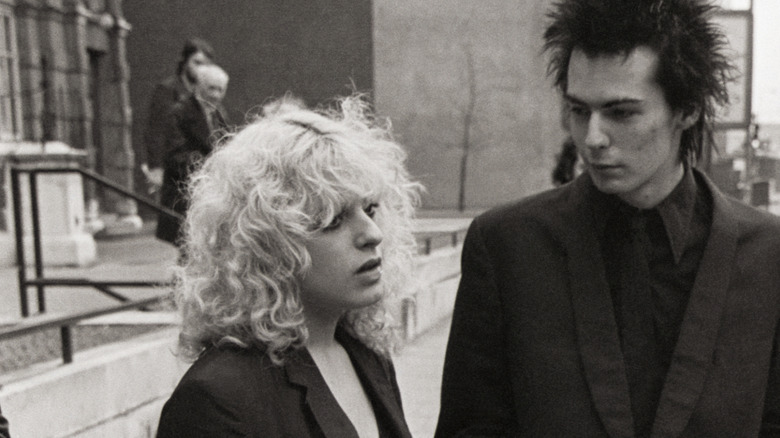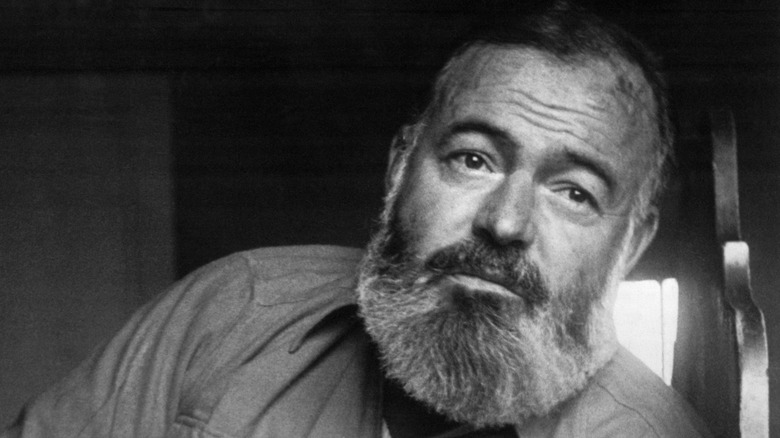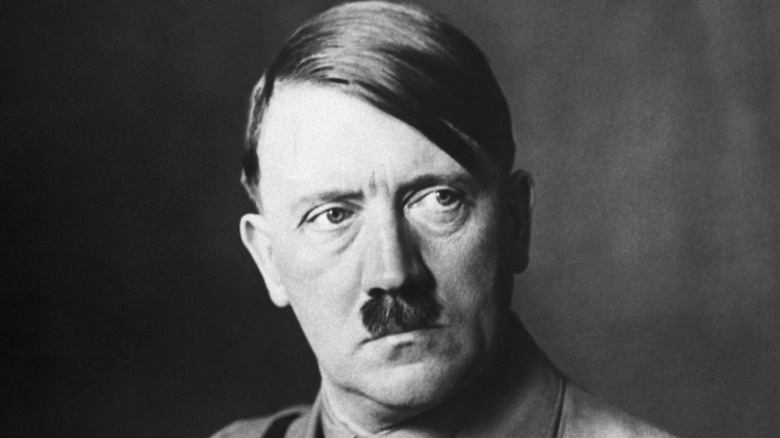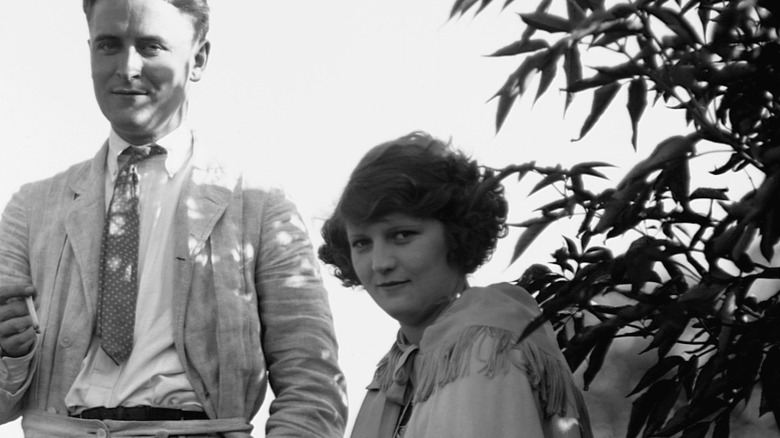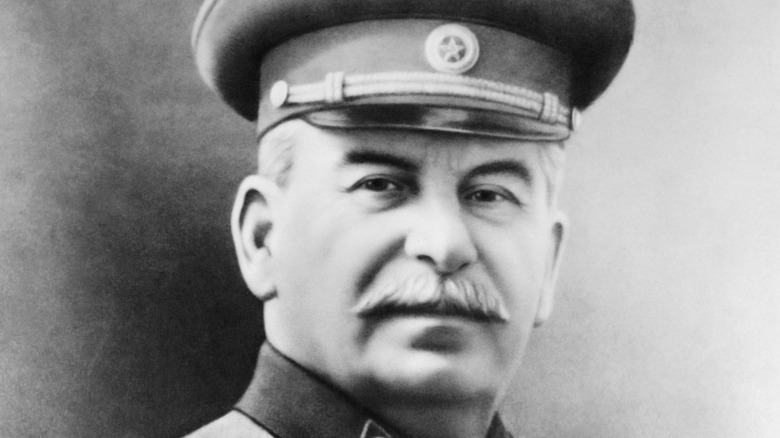Things Found At Famous People's Death Scenes
The following article contains descriptions of drug addiction and suicide, and references child abuse.
From ruthless dictators to princesses, when someone well-known dies suddenly and unexpectedly, the public is left wanting answers. If they died while alone, it can be difficult to know with complete certainty what happened in the moments before someone's death — but sometimes the physical objects around them can help provide some answers, or at least more information about their final days, their intentions, and what plans they might have had for the future.
The details of the things found at the death scenes of these notable individuals paint an incomplete picture, leaving out the reality of their accomplishments or crimes, and their day to day lives — but they can still help to fill in some missing pieces about what happened to these famous individuals. In some cases, their deaths were sudden and impossible to predict while others were the result of decades-long struggles with addiction or mental health issues. In other scenarios, things found in the aftermath of these deaths revealed hidden truths about people so famous that it seemed impossible that they had any secrets left to hide.
Marilyn Monroe
In 1962, Hollywood icon Marilyn Monroe was found dead by her housekeeper and her psychiatrist. She was in her own bed and the cause of death seemed clear: overdose. In addition to her phone, which she seemed to have been either holding or reaching for at the time of her death, there were multiple pill bottles near the bed, including various uppers and downers which Monroe was known to take regularly, often along with alcohol.
One bottle should have contained Nembutal: a barbiturate sedative drug often used to put patients under for surgical procedures. Monroe is believed to have taken Nembutal along with another sedative called chloral hydrate and alcohol to fall asleep. Monroe had been prescribed this medication shortly before her death, but she was only supposed to take one pill a night. When her body was found, the bottle was empty.
Because the deputy medical examiner who performed the autopsy shortly after her death reported no sign of the drug in her stomach, conspiracy theories have sprung up around the star's death, with some believing that the Nembutal that was found in her room was a cover-up for some other cause of death. These theories were so prevalent that decades later in 1982 the case was actually reopened — during which it was determined that there was enough time between when Monroe would have taken the medication and when the autopsy took place for all traces of it to have left her stomach.
Nancy Spungen
In the 1970s, Nancy Spungen was a well-known groupie from the NYC punk scene with a reputation for bringing hard drugs to members of the bands that she followed. After traveling to England, she began dating the Sex Pistols' replacement bassist Sid Vicious. Even though Spungen drove a wedge between Vicious and the other members of the band, the couple became inseparable. The two were increasingly volatile, with Vicious lashing out physically at fans, Spungen harming herself, and both using more and more drugs. Then, in 1978, Spungen was found murdered in the famous Chelsea Hotel in New York City. She had been stabbed and Vicious was presumed guilty.
Exactly what happened the night of Spungen's murder is unknown. While it is still generally believed that Vicious murdered her, some have suggested that he was actually incapacitated due to his drug use at the time. The items found at the crime scene offer significant insight into the chaotic way the two had been living but offer few clues about the crime.
The Forensic Crime Scene Unit which investigated the crime scene was primarily looking for the knife. They found plenty — Vicious had a knife collection. Later, a young associate medical examiner named Dr. Greeta Natarajan discovered several blood-soaked hypodermic needles and barbiturates in the room with the body. They also found all of Spungen and Vicious's possessions, including a massive amount of stockings and photos of the couple, stuffed into plastic Harrods bags.
Tennessee Williams
In 1983, Tennessee Williams, the famous playwright behind "A Streetcar Named Desire," was found dead in his New York City hotel room by his secretary. Bizarrely, the autopsy found that he had died of asphyxiation, having choked on a small plastic cap, seemingly for an eye drop or nasal spray bottle. The cap may have been the cause of death, but it was not the only culprit. Also found in the room with Williams were an empty bottle of wine and pills. The medical examiner would later reveal that he had taken the insomnia medication barbiturate Secobarbital before he died.
There were many tragic stories in the life of Tennessee Williams, and his long-term issues with sleeping pills and alcohol are among them. Earlier in life, Williams had been prescribed many different drugs by a notorious physician named Max Jacobson, better known as "Dr. Feelgood". Jacobson was known for injecting his celebrity patients with amphetamines. While Jacobson refused to treat Williams after an incident where the playwright had reportedly been drinking in the medical office, Williams found other doctors to prescribe for him.
Michael Jackson
The room where Michael Jackson died had an array of medical items, including oxygen tanks, an IV stand, and the deadly cocktail of prescription drugs that his doctor had given him. While Michael Jackson's cause of death was detailed in his autopsy report, the things found in his home after his death reveal a far darker and more disturbing image of the former King of Pop. In the aftermath of Jackson's death in 2009, a multitude of sinister things were found in his house by police investigators.
According to Digital Music News, in addition to large amounts of pornography of all kinds featuring both adult men and women, there were several books containing images of nude children. Even more distressing were a pair of items collectively known as Evidence Item #510 to the police. One was a bag filled with clothes, including children's clothes. The other was a plastic Disneyland bag, full of underwear and bloody bed sheets.
Princess Diana
The various causes of the heartbreaking death of Princess Diana, including how intoxicated her limousine driver was, that she was not wearing a seatbelt, and that she was being harassed and chased at high speeds by the paparazzi, have been topics of discussion since 1997 when the beloved royal was killed in a high-speed collision in Paris. Exactly what the crash looked like is thankfully mostly unknown, as the cameras of the paparazzi who attempted to photograph it were confiscated — but the police chief who led the investigation at the scene of the accident, Martine Monteil described arriving at the scene of the deadly crash in a documentary series called Investigating Diana: Death in Paris (reported on by Newsweek).
Monteil stated that she was there to notice all the small details at the crime scene, like shattered glass and debris — but she also found some signs that Princess Diana had been in the accident. Monteil described a particularly poignant discovery from the crime scene: tiny pearls scattered around the crash. It is believed that the princess was wearing them when the accident occurred.
Ernest Hemingway
Famed author of "The Old Man and the Sea," "The Sun Also Rises," and "For Whom the Bell Tolls," Ernest Hemingway had an unbelievable life story, but he was believed to have struggled with bipolar disorder, alcoholism, and depression. Hemingway had received inpatient treatment for his mental health following several suicide attempts but had been deemed ready to leave the hospital, against the wishes of his wife, Mary. Two days later, he died by suicide. The gun he used and the key that allowed him to access it have been the source of controversy.
Hemingway's wife knew that there were guns in their home which could prove a risk to her suicidal husband, so she locked them up in their storage room. Then, she put the keys on top of their kitchen window — something that was later questioned by Hemingway's son Patrick, per The Washington Post. Mary Hemingway, however, stated that she didn't feel that she had the right to fully prevent him from accessing his things. Tragically, his wife found his body in the entryway of their home, dressed in his bathrobe, with one of his shotguns.
Grace Kelly
When Hollywood star Grace Kelly, known for films like "Rear Window" and "High Noon," married the Prince of Monaco in 1956, it seemed like the beginning of a fairy tale. In 1982, her car went careening through a retaining wall before crashing more than 100 feet off a cliff. The only people in the car, a green Rover 3500, were Kelly and her daughter Stephanie, and the only things in the car with them were a large assortment of dresses and boxes in the backseat. Stephanie was on her way to a new school in Paris and the backseat was piled high with everything she would need to bring with her. Tragically, that was the reason that Kelly was behind the wheel.
There's a lot that most people don't know about Grace Kelly — including that she rarely drove herself anywhere. Some have suggested that Stephanie was the driver, that the mother and daughter were arguing, or that the car's brakes had malfunctioned. The truth was likely even simpler than that, however. Kelly was feeling unwell on the day of her death and, even on a good day, she usually had a professional driver. She only got behind the wheel because, with all of Stephanie's things in the backseat, there wasn't room for three people in the car. There is evidence Kelly may have had a mild stroke while driving, but all things combined, the exact cause of the accident will likely never be known.
Adolf Hitler
Most people know that the dictator of the Third Reich died by suicide in a bunker under the streets of Berlin as the city was taken by Allied forces — but less common knowledge are the things found at Adolf Hitler's death scene. While the term "bunker" might conjure up images of a dark little bomb shelter, the place where Hitler and his inner circle spent their final days was opulent. The entrance was lined with a red carpet, the walls were hung with stolen art, and he was served by a full staff. When soldiers arrived, they found the bunker partially burned, but the art and fancy furniture (some of it bloodstained) inside still painted a picture of the oddly luxurious lifestyle Hitler had, before handing out cyanide capsules to his inner circle, feeding one to his dog, and killing himself by gunfire.
Other items found in and around the bunker have less to do with the final moments of Adolf Hitler and the other Nazis who died inside and more to do with those who arrived after their deaths. Inside, there was a massive safe which had been broken open and the contents stolen. Around the outside were empty gas canisters, which his soldiers used to burn the corpses of Hitler and his new wife, Eva Braun.
Heath Ledger
Actor Heath Ledger died at the age of 28, already having had a career packed with iconic films and diverse roles, from "Brokeback Mountain" to "The Dark Knight." His body was found in his bedroom in his New York City apartment. Descriptions of the pills that were found in the room, Xanax, Valium, and Ambien, dominated the news cycle following his death, as stunned fans grappled with the sudden loss of the young actor. Another pair of items in his bedroom at the time of his death tells a different story about Ledger, however: a book by Malcolm Gladwell and the script for a film adaptation.
The highly anticipated film was to be directed by Stephen Gaghan and originally had Leonardo DiCaprio attached to star. During development, however, the leading character was reimagined as a much younger man, and Heath Ledger seemed perfect for the role. Gaghan stated in a podcast that he hoped it was going to be the first in a number of collaborations between them, according to The Hollywood Reporter.
Zelda Fitzgerald
F. Scott Fitzgerald's famous socialite wife Zelda created an image of herself that was larger than life. In some ways, her reputation as the quintessential flapper of the 1920s was so large it eclipsed the real Zelda — a dancer, artist, and writer so eloquent that Fitzgerald stole some of his best lines straight from her journals. She also had significant mental health struggles and spent much of her life in various hospitals and treatment facilities, concluding with a mental hospital in Asheville, North Carolina.
Horrifically, the hospital caught fire, killing nine patients, including Zelda Fitzgerald. She was sedated at the time and had no chance of escape. Her body was not discovered amidst the rubble until the following day. Although it has never been confirmed, legend has it that her body was discovered with a single charred ballet slipper. Whether she really was wearing dancing shoes at the time of her death, or that story is simply another part of the larger-than-life story of Zelda Fitzgerald is unknown.
Joseph Stalin
Soviet dictator Joseph Stalin's decline began in 1945 when a major medical event (possibly a stroke or heart attack) took a major toll on both his physical and mental health — not that he would admit it. In 1951, a doctor who advised Stalin to take better care of himself was charged as a spy for daring to question the dictator's physical state. This kicked off a state-wide persecution of medical professionals. Their expertise might have been useful to Stalin – if he had believed them. Finally, on March 1, 1953, Stalin did not come out of his chambers. He did not call for food or work. His staff, terrified to disobey the order never to go into his private rooms uninvited, did not investigate further until 11 p.m.
Stalin was dying. What they found inside with the dictator lying on the floor provided few clues into what exactly had happened. A newspaper and a pocket watch were on the floor with Stalin, and the watch had stopped at 6:30 a.m., meaning that he had been on the floor all day without assistance. The only other thing of note was a bottle of mineral water on the table near him, leading some to theorize that he was getting up to have a drink when he collapsed.
Kurt Cobain
In 1994, famed Nirvana frontman Kurt Cobain died by suicide at his home, ending his life in the greenhouse above the garage. His struggles with depression and addiction were known to his loved ones, who had attempted to get him help, even holding an intervention for him the month before his death. Although Cobain temporarily checked into a clinic, he ultimately returned home and locked himself inside.
There are some things that were only learned about Kurt Cobain after his death, but exactly what happened before his death is obviously unknown. Fans, desperate for answers, constructed their own conspiracy theories. However, reports about the few items found with the body have helped to paint a picture of what his final moments were like. On the ground were his hat, which served as a kind of disguise in public, a cigar box where he kept the drugs that he took before his death, and his wallet, open to his ID, seemingly to help whoever found him to identify his body. Along with the gun he used, investigators also found Cobain's suicide note, stabbed into the soil of a planter with the pen.
If you or anyone you know needs help with addiction issues, may be the victim of child abuse, or struggles with depression or suicidal ideation, contact the relevant resources below:
-
988 Suicide & Crisis Lifeline. Call or text 988 or chat 988lifeline.org.
-
The Childhelp National Child Abuse Hotline: call 1-800-4-A-Child (1-800-422-4453) or contact their live chat services.
-
The Substance Abuse and Mental Health Services Administration website or SAMHSA's National Helpline at 1-800-662-HELP (4357).
